
Joseph Lister, 1st Baron Lister, was a British surgeon, medical scientist, experimental pathologist and a pioneer of antiseptic surgery and preventative medicine. Joseph Lister revolutionised the craft of surgery in the same manner that John Hunter revolutionised the science of surgery.

Dr. Hannibal Lecter is a fictional character created by the novelist Thomas Harris. Lecter is a serial killer who eats his victims. Before his capture, he was a respected forensic psychiatrist; after his incarceration, he is consulted by FBI agents Will Graham and Clarice Starling to help them find other serial killers.
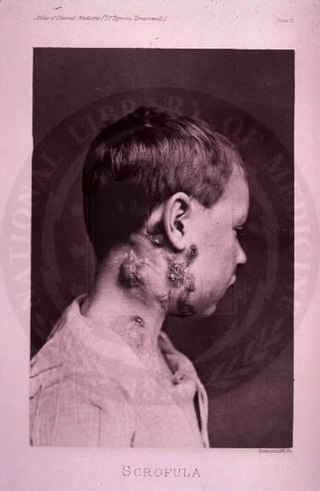
The disease mycobacterial cervical lymphadenitis, also known as scrofula and historically as king's evil, involves a lymphadenitis of the cervical lymph nodes associated with tuberculosis as well as nontuberculous (atypical) mycobacteria.

Abū al-Qāsim Khalaf ibn al-'Abbās al-Zahrāwī al-Ansari, popularly known as al-Zahrawi (الزهراوي), Latinised as Albucasis, was an Arab Andalusian physician, surgeon and chemist. Considered to be the greatest surgeon of the Middle Ages, he has been referred to as the "father of modern surgery".

Medieval medicine in Western Europe was composed of a mixture of pseudoscientific ideas from antiquity. In the Early Middle Ages, following the fall of the Western Roman Empire, standard medical knowledge was based chiefly upon surviving Greek and Roman texts, preserved in monasteries and elsewhere. Medieval medicine is widely misunderstood, thought of as a uniform attitude composed of placing hopes in the church and God to heal all sicknesses, while sickness itself exists as a product of destiny, sin, and astral influences as physical causes. On the other hand, medieval medicine, especially in the second half of the medieval period, became a formal body of theoretical knowledge and was institutionalized in the universities. Medieval medicine attributed illnesses, and disease, not to sinful behaviour, but to natural causes, and sin was connected to illness only in a more general sense of the view that disease manifested in humanity as a result of its fallen state from God. Medieval medicine also recognized that illnesses spread from person to person, that certain lifestyles may cause ill health, and some people have a greater predisposition towards bad health than others.

Ambroise Paré was a French barber surgeon who served in that role for kings Henry II, Francis II, Charles IX and Henry III. He is considered one of the fathers of surgery and modern forensic pathology and a pioneer in surgical techniques and battlefield medicine, especially in the treatment of wounds. He was also an anatomist, invented several surgical instruments, and was a member of the Parisian barber surgeon guild.
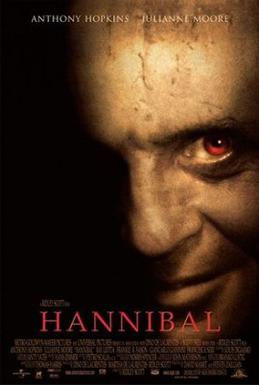
Hannibal is a 2001 psychological horror crime thriller film directed by Ridley Scott and based on the 1999 novel by Thomas Harris. A sequel to the 1991 film The Silence of the Lambs, the plot follows disgraced FBI special agent Clarice Starling as she attempts to apprehend cannibalistic serial killer Hannibal Lecter before his surviving victim, Mason Verger, captures him. Anthony Hopkins reprises his role as Lecter, while Julianne Moore replaces Jodie Foster as Starling and Gary Oldman plays Verger. Ray Liotta, Frankie R. Faison, Giancarlo Giannini, and Francesca Neri also star.
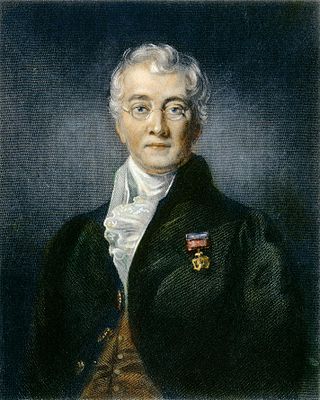
Sir Charles Bell was a Scottish surgeon, anatomist, physiologist, neurologist, artist, and philosophical theologian. He is noted for discovering the difference between sensory nerves and motor nerves in the spinal cord. He is also noted for describing Bell's palsy.

Clarice M. Starling is a fictional character and protagonist of the novels The Silence of the Lambs (1988) and Hannibal (1999) by Thomas Harris.

The Edwin Smith Papyrus is an ancient Egyptian medical text, named after Edwin Smith who bought it in 1862, and the oldest known surgical treatise on trauma. From a cited quotation in another text, it may have been known to ancient surgeons as the "Secret Book of the Physician".

Red Dragon is a psychological horror novel by American author Thomas Harris, first published in 1981. The plot follows former FBI profiler Will Graham, who comes out of retirement to find and apprehend an enigmatic serial killer nicknamed "the Tooth Fairy". The novel introduced the character Dr. Hannibal Lecter, a brilliant psychiatrist and cannibalistic serial killer whom Graham reluctantly turns to for advice and with whom he has a dark past. The title refers to the figure from William Blake's painting The Great Red Dragon and the Woman Clothed in Sun.

Medicine in ancient Rome was highly influenced by ancient Greek medicine, but also developed new practices through knowledge of the Hippocratic Corpus combined with use of the treatment of diet, regimen, along with surgical procedures. This was most notably seen through the works of two of the prominent Greek physicians, Dioscorides and Galen, who practiced medicine and recorded their discoveries. This is contrary to two other physicians like Soranus of Ephesus and Asclepiades of Bithynia, who practiced medicine both in outside territories and in ancient Roman territory, subsequently. Dioscorides was a Roman army physician, Soranus was a representative for the Methodic school of medicine, Galen performed public demonstrations, and Asclepiades was a leading Roman physician. These four physicians all had knowledge of medicine, ailments, and treatments that were healing, long lasting and influential to human history.
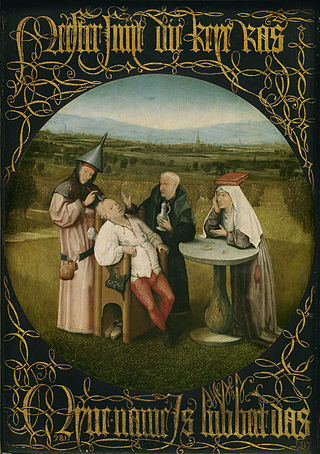
Surgery is the branch of medicine that deals with the physical manipulation of a bodily structure to diagnose, prevent, or cure an ailment. Ambroise Paré, a 16th-century French surgeon, stated that to perform surgery is, "To eliminate that which is superfluous, restore that which has been dislocated, separate that which has been united, join that which has been divided and repair the defects of nature."
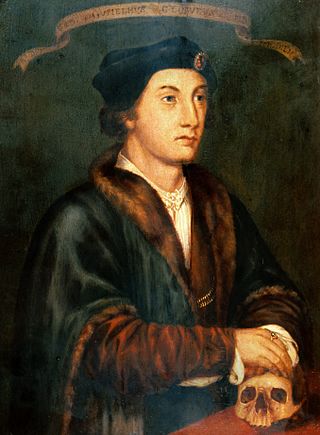
William Clowes the Elder was an early English surgeon. He published case reports in which he advocated the application of powders and ointments. He also published one of the first reports in English on how to reduce a femur.

Frederick "Freddy" Lounds is a fictional character in the Hannibal Lecter series, created by author Thomas Harris. Lounds first appears in the 1981 novel Red Dragon as a foil to protagonist Will Graham. Lounds is ultimately murdered by the novel's primary antagonist, serial killer Francis Dolarhyde.

Will Graham is a fictional character and protagonist of Thomas Harris' 1981 novel Red Dragon. Graham is also the protagonist of two film adaptations of the novel, Manhunter (1986) and Red Dragon (2002), and the television series Hannibal (2013–2015), which adapted various parts of the Hannibal Lecter franchise.
"Apéritif" is the series premiere of the psychological thriller–horror series Hannibal. The episode was written by Bryan Fuller, and directed by David Slade. It was first broadcast on April 4, 2013, on NBC. The series is based on characters and elements appearing in Thomas Harris' novels Red Dragon and Hannibal, with focus on the relationship between FBI special investigator Will Graham and Dr. Hannibal Lecter, a forensic psychiatrist destined to become Graham's most cunning enemy.
"Mizumono" is the thirteenth episode and season finale of the second season of the psychological thriller–horror series Hannibal. It is the 26th overall episode of the series and was written by executive producer Steve Lightfoot and series creator Bryan Fuller, and directed by executive producer David Slade. It was first broadcast on May 23, 2014, on NBC.
"Primavera" is the second episode of the third season of the psychological thriller–horror series Hannibal. It is the 28th overall episode of the series and was written by co-executive producer Jeff Vlaming and series creator Bryan Fuller, and directed by Vincenzo Natali. It was first broadcast on June 11, 2015, on NBC.
John Henry WishartFRCSEdFRSE was a Scottish surgeon who worked at the Royal Infirmary of Edinburgh. Although a general surgeon, he developed a special interest in the diagnosis and treatment of eye disease. He translated into English three major works of the Italian anatomist and surgeon Antonio Scarpa. With John Argyll Robertson, Wishart jointly founded the Edinburgh Eye Dispensary. He was surgeon in Scotland to King George IV and served as President of the Royal College of Surgeons of Edinburgh from 1820 to 1822.


















